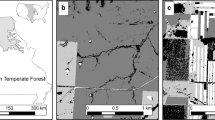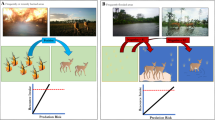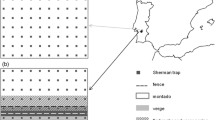Abstract
Behavioural strategies may have important fitness, ecological and evolutionary consequences. In woodland caribou, human disturbances are associated with higher predation risk. Between 2004 and 2011, we investigated if habitat selection strategies of female caribou towards disturbances influenced their calf’s survival in managed boreal forest with varying intensities of human disturbances. Calf survival was 53 % and 43 % after 30 and 90 days following birth, respectively, and 52 % of calves that died were killed by black bear. The probability that a female lose its calf to predation was not influenced by habitat composition of her annual home range, but decreased with an increase in proportion of open lichen woodland within her calving home range. At the local scale, females that did not lose their calf displayed stronger avoidance of high road density areas than females that lost their calf to predation. Further, females that lost their calf to predation and that had a low proportion of ≤5-year-old cutovers within their calving home range were mostly observed in areas where these young cutovers were locally absent. Also, females that lost their calf to predation and that had a high proportion of ≤5-year-old cutovers within their calving home range were mostly observed in areas with a high local density of ≤5-year-old cutovers. Our study demonstrates that we have to account for human-induced disturbances at both local and regional scales in order to further enhance effective caribou management plans. We demonstrate that disturbances not only impact spatial distribution of individuals, but also their reproductive success.


Similar content being viewed by others
References
Addessi L (1994) Human disturbance and long-term changes on a rocky intertidal community. Ecol Appl 4:786–797
Austin D, Bowen WD, McMillan JI (2004) Intraspecific variation in movement patterns: modeling individual behaviour in a large marine predator. Oikos 105:15–30. doi:10.1111/j.0030-1299.1999.12730.x
Ballard WB (1994) Effects of black bear predation on caribou—a review. Alces 30:25–35
Bastille-Rousseau G, Fortin D, Dussault C, Courtois R, Ouellet J-P (2011) Foraging strategies by omnivores: are black bears actively searching for ungulate neonates or are they simply opportunistic predators? Ecography 34:588–596. doi:10.1111/j.1600-0587.2010.06517.x
Bergerud AT (1972) Food habits of Newfoundland caribou. J Wildl Manage 36:913–923
Beyer HL, Ung R, Murray DL, Fortin M-J (2013) Functional responses, seasonal variation and thresholds in behavioural responses of moose to road density. J Appl Ecol 50:286–294. doi:10.1111/1365-2664.12042
Blumstein DT, Fernandez-Juricic E, Zollner PS, Garity SC (2005) Inter-specific variation in avian responses to human disturbance. J Appl Ecol 42:943–953. doi:10.1111/j.1365-2664.2005.01071.x
Bock MD, Van Rees KCJ (2002) Forest harvesting impacts on soil properties and vegetation communities in the Northwest Territories. Can J For Res 32:713–724. doi:10.1139/X02-014
Burton PJ, Messier C, Weetman GF, Prepas EE, Adamowicz WL, Tittler R (2003) The current state of boreal forestry and the drive for change. In: Burton PJ, Messier C, Smith DW, Adamowicz WL (eds) Towards sustainable management of the boreal forest. NRC Research Press, Canada, pp 1–40
Canada Environment (2011) Scientific assessment to inform the identification of critical habitat for woodland caribou (Rangifer tarandus caribou), Boreal population, in Canada: 2011 update. Environment Canada, Ottawa
Carr NL, Rodgers AR, Walshe S (2007) Caribou nursery site habitat characteristics in two northern Ontario parks. Rangifer 17:167–179. doi:10.7557/2.27.4.343
Chan-McLoed ACA, White RG, Holleman DF (1994) Effects of protein and energy-intake, body condition, and season on nutrient partitioning and milk production in caribou and reindeer. Can J Zool 72:938–947
Courtois R, Ouellet J-P, Breton L, Gingras A, Dussault C (2007) Effects of forest disturbance on density, space use, and mortality of woodland caribou. Ecoscience 14:491–498
Courtois R, Gingras A, Fortin D, Sebbane A, Rochette B, Breton L (2008) Demographic and behavioural response of woodland caribou to forest harvesting. Can J For Res 38:2837–2849. doi:10.1139/X08-119
Cox DR (1972) Regression models and life-tables. J Roy Stat Soc B 34:187–220
Dussault C, Pinard V, Ouellet J-P, Courtois R, Fortin D (2012) Avoidance of roads and selection for recent cutovers by threatened caribou: fitness-rewarding or maladaptive behaviour? Proc R Soc B 279:4481–4488. doi:10.1098/rspb.2012.1700
Faille G, Dussault C, Ouellet J-P, Fortin D, Courtois R, St-Laurent M-H, Dussault C (2010) Range fidelity: the missing link between caribou decline and habitat alteration? Biol Cons 143:2840–2850. doi:10.1016/j.biocon.2010.08.001
Festa-Bianchet M, Ray JC, Côté SD, Gunn A (2011) Conservation of caribou (Rangiger tarandus) in Canada: an uncertain future. Can J Zool 89:419–434. doi:10.1139/Z11-025
Fischer JT, Wilkinson L (2005) The response of mammals to forest fire and timber harvest in the North American boreal forest. Mammal Rev 35:51–81. doi:10.1111/j.1365-2907.2005.00053.x
Gaillard J-M, Festa-Bianchet M, Yoccoz NG, Loison A, Toigo C (2000) Temporal variation in fitness components and population dynamics of large herbivores. Ann Rev Ecol Syst 31:367–393
Godvik IMR, Loe LE, Vik JO, Veiberg V, Langvatin R, Mysterud A (2009) Temporal scales, trade-offs, and functional responses in red deer habitat selection. Ecology 90:699–710. doi:10.1890/08-0576.1
Graham MH (2003) Confronting multicollinearity in ecological multiple regression. Ecology 84:2809–2815. doi:10.1890/02-3114
Gustine DD, Parker KL, Lay RJ, Gillingham MP, Heard DC (2006) Calf survival of woodland caribou in a multi-predator ecosystem. Wildl Monogr 165:1–32. doi:10.2193/0084-0173(2006)165[1:CSOWCI]2.0.CO;2
Hansen BB, Herfindal I, Aanes R, Saether B-E, Henriksen S (2009) Functional response in habitat selection and the tradeoffs between foraging niche components in a large herbivore. Oikos 118:859–872. doi:10.1111/j.1600-0706.2009.17098.x
Hebblewhite M, Merrill E (2008) Modelling wildlife—human relationships for social species with mixed-effects resource selection models. J Appl Ecol 45:834–844. doi:10.1111/j.1365-2664.2008.01466.x
Hins C, Ouellet J-P, Dussault C, St-Laurent M-H (2009) Habitat selection by forest-dwelling caribou in managed boreal forest of eastern Canada: evidence of a landscape configuration effect. For Ecol Manage 257:636–643. doi:10.1016/j.foreco.2008.09.049
Houle M, Fortin D, Dussault C, Courtois R, Ouellet J-P (2010) Cumulative effects of forestry on habitat use by gray wolf (Canis lupus) in the boreal forest. Landsc Ecol 25:419–433. doi:10.1007/s10980-009-9420-2
James ARC, Stuart-Smith AK (2000) Distribution of caribou and wolves in relation to linear corridors. J Wildl Manage 64:154–159
James ARC, Boutin S, Hebert DM, Blair Rippin A (2004) Spatial separation of caribou from moose and its relation to predation by wolves. J Wildl Manage 68:799–809. doi:10.2193/0022-541X(2004)068[0799:SSOCFM]2.0.CO;2
Johnson DH (1980) The comparison of usage and availability measurements for evaluating resource preference. Ecology 61:65–71
Johnson CJ, St-Laurent M-H (2011) Unifying framework for understanding impacts of human developments on wildlife. In: Naugle DE (ed) Energy development and wildlife conservation in western North America. Island Press, Washington, pp 27–54
Lantin É, Drapeau P, Paré M, Bergeron Y (2003) Preliminary assessment of habitat characteristics of woodland caribou calving areas in the Claybelt region of Québec and Ontario, Canada. Rangifer 14:247–254. doi:10.7557/2.23.5.1708
Leblond M, Frair J, Fortin D, Dussault C, Ouellet J-P, Courtois R (2011) Assessing the influence of resource covariates at multiple spatial scales: an application to forest-dwelling caribou faced with intensive human activity. Landsc Ecol 26:1433–1446. doi:10.1007/s10980-011-9647-6
Leblond M, Dussault C, Ouellet J-P (2013) Avoidance of roads by large herbivores and its relation to disturbance intensity. J Zool 289:32–40. doi:10.1111/j.1469-7998.2012.00959.x
Leclerc M, Dussault C, St-Laurent M-H (2012) Multiscale assessment of the impacts of roads and cutovers on calving site selection in woodland caribou. For Ecol Manage 286:59–65. doi:10.1016/j.foreco.2012.09.010
Lesmerises F, Dussault C, St-Laurent M-H (2012) Wolf habitat selection is shape by human activities in a highly managed boreal forest. For Ecol Manage 276:125–131. doi:10.1016/j.foreco.2012.03.025
Mabille G, Dussault C, Ouellet J-P, Laurian C (2012) Linking trade-offs in habitat selection with the occurrence of functional responses for moose living in two nearby study areas. Oecologia 170:965–977. doi:10.1007/s00442-012-2382-0
Mahoney SP, Virgl JA (2003) Habitat selection and demography of a nonmigratory woodland caribou population in Newfoundland. Can J Zool 81:321–334. doi:10.1139/z02-239
Manly BFJ, McDonald LL, Thomas DL, McDonald TL, Erickson WP (2002) Resource selection by animals: Statistical design and analysis for field studies, 2nd edn. Kluwer Academic Publishers, Dordrecht
McLoughlin PD, Dunford JS, Boutin S (2005) Relating predation mortality to broad-scale habitat selection. J Anim Ecol 74:701–707. doi:10.1111/j.1365-2656.2005.00967.x
Moreau G, Fortin D, Couturier S, Duchesne T (2012) Multi-level functional responses for wildlife conservation: the case of threatened caribou in managed boreal forest. J Appl Ecol 49:611–620. doi:10.1111/j.1365-2664.2012.02134.x
Mosnier A, Ouellet J-P, Courtois R (2008) Black bear adaptation to low productivity in the boreal forest. Ecoscience 15:485–497. doi:10.2980/15-4-3100
Mysterud A, Ims RA (1998) Functional responses in habitat use: availability influences relative use in trade-off situations. Ecology 79:1435–1441. doi:10.1890/0012-9658(1998)079[1435:FRIHUA]2.0.CO;2
Phillips GE, Alldredge AW (2000) Reproductive success of elk following disturbance by humans during calving season. J Wildl Manage 64:521–530
Pinard V, Dussault C, Ouellet J-P, Fortin D, Courtois R (2012) Calving rate, calf survival rate, and habitat selection of forest-dwelling caribou in a highly managed landscape. J Wildl Manage 76:189–199. doi:10.1002/jwmg.217
Potvin F, Breton L (1988) Use of a net gun for capturing white-tailed deer, Odocoileus virginianus, on Anticosti Island, Québec. Can Field Nat 102:697–700
R Development Core Team (2012) A language and environment for statistical computing. R foundation for statistical computing, Austria
Raithel JD, Kauffman MJ, Pletscher DH (2007) Impact of spatial and temporal variation in calf survival on the growth of elk populations. J Wildl Manage 71:795–803. doi:10.2193/2005-608
Réale D, Festa-Bianchet M (2003) Predator-induced natural selection on temperament in bighorn ewes. Anim Behav 65:463–470. doi:10.1006/anbe.2003.2100
Réale D, Dingemanse NJ, Kazem AJN, Wright J (2010) Evolutionary on ecological approaches to the study of personality. Phil Trans R Soc B 365:3937–3946. doi:10.1098/rstb.2010.0222
Robitaille A, Saucier J-P (1998) Paysages régionaux du Québec méridional. Les publications du Québec, Québec
Rognmo A, Markussen KA, Jacobsen E, Grav HJ, Blix AS (1983) Effects of improved nutrition in pregnant reindeer on mil quality, calf birth weight, growth, and mortality. Rangifer 3:10–18
Sanderson EW, Malanding J, Levy MA, Redford KH, Wannebo AW, Woolmer G (2002) The human footprint and the last of the wild. Bioscience 52:891–904. doi:10.1641/0006-3568(2002)052[0891:THFATL]2.0.CO;2
Schlaepfer MA, Runge MC, Sherman PW (2002) Ecological and evolutionary traps. Trends Ecol Evol 17:474–480. doi:10.1016/S0169-5347(02)02580-6
Seip DR (1991) Predation and caribou populations. Rangifer 7:46–52
Seip DR, Cichowski DB (1996) Population ecology of caribou in British Columbia. Rangifer 9:73–80
Sih A, Bell A, Johnson JC (2004) Behavioral syndromes: an ecological and evolutionary overview. Trends Ecol Evol 19:372–378. doi:10.1016/j.tree.2004.04.009
Smith BR, Blumstein DT (2008) Fitness consequences of personality: a meta-analysis. Behav Ecol 19:448–455. doi:10.1093/beheco/arm144
St-Laurent M-H, Dussault C (2012) The reintroduction of boreal caribou as a conservation strategy: a long-term assessment at the southern range limit. Rangifer 20:127–138. doi:10.7557/2.32.2.2261
Vors LS, Schaefer JA, Pond BA, Rodgers AR, Patterson BR (2007) Woodland caribou extirpation and anthropogenic landscape disturbance in Ontario. J Wildl Manage 71:1249–1256. doi:10.2193/2006-263
White RG (1983) Foraging patterns and their multiplier effects on productivity of northern ungulates. Oikos 40:377–384
Whittington J, Hebblewhite M, DeCesare NJ, Neufeld L, Bradley M, Wilmshurst J, Musiani M (2011) Caribou encounters with wolves increase near roads and trails: a time-to-event approach. J Appl Ecol 48:1535–1542. doi:10.1111/j.1365-2664.2011.02043.x
Wikelski M, Cooke SJ (2006) Conservation physiology. Trends Ecol Evol 21:38–46. doi:10.1016/j.tree.2005.10.018
Williams R, Lusseau D, Hammond PS (2006) Estimating relative energetic costs of human disturbance to killer whale (Orcinus orca). Biol Cons 133:301–311. doi:10.1016/j.biocon.2006.06.010
Wilson DS (1998) Adaptive individual differences within single populations. Phil Trans Roy Soc B 353:199–205. doi:10.1098/rstb.1998.0202
Wilson DS, Clark AB, Coleman K, Dearstyne T (1994) Shyness and boldness in humans and other animals. Trends Ecol Evol 9:442–446. doi:10.1016/0169-5347(94)90134-1
Wittmer HU, McLellan BN, Serrouya R, Apps CD (2007) Changes in landscape composition influence the decline of a threatened woodland caribou population. J Anim Ecol 76:568–579. doi:10.1111/j.1365-2656.2007.01220.x
Acknowledgments
We thank B. Baillargeon, C. Bourgeois, L. Breton, L. Coulombe, R. Courtois, Cl. Dussault, J.-G. Frenette, S. Gravel, D. Grenier, R. Lavoie, D. Lacasse, M. Poulin and S. St-Onge for caribou captures. We also thank J.-P. Ouellet for his scientific contribution, A. Caron and M. Mazerolle for statistical advices, and J. Bêty, C. Johnson, A. Skarin, and P. and M. Fast for useful comments on earlier versions of the manuscript. This project was funded by the Fonds de recherche du Québec—Nature et technologies, the Fonds de recherche forestière du Saguenay–Lac-St-Jean, the Natural Sciences and Engineering Research Council of Canada (Discovery Grant to M.-H. St-Laurent), the Ministère des Forêts, de la Faune et des Parcs du Québec, the Conseil de l’Industrie Forestière du Québec, the Fédération Canadienne de la Faune, the Fondation de la Faune du Québec, the World Wildlife Fund for Nature, Produits Forestier Résolu Inc., and the Université du Québec à Rimouski. We also thank the Essipit First Nation for providing access to their caribou telemetry data, via the Aboriginal Funds for Species at Risk (Environment Canada).
Author information
Authors and Affiliations
Corresponding author
Additional information
Communicated by Göran C. Ericsson.
Electronic supplementary material
Below is the link to the electronic supplementary material.
Rights and permissions
About this article
Cite this article
Leclerc, M., Dussault, C. & St-Laurent, MH. Behavioural strategies towards human disturbances explain individual performance in woodland caribou. Oecologia 176, 297–306 (2014). https://doi.org/10.1007/s00442-014-3012-9
Received:
Accepted:
Published:
Issue Date:
DOI: https://doi.org/10.1007/s00442-014-3012-9




